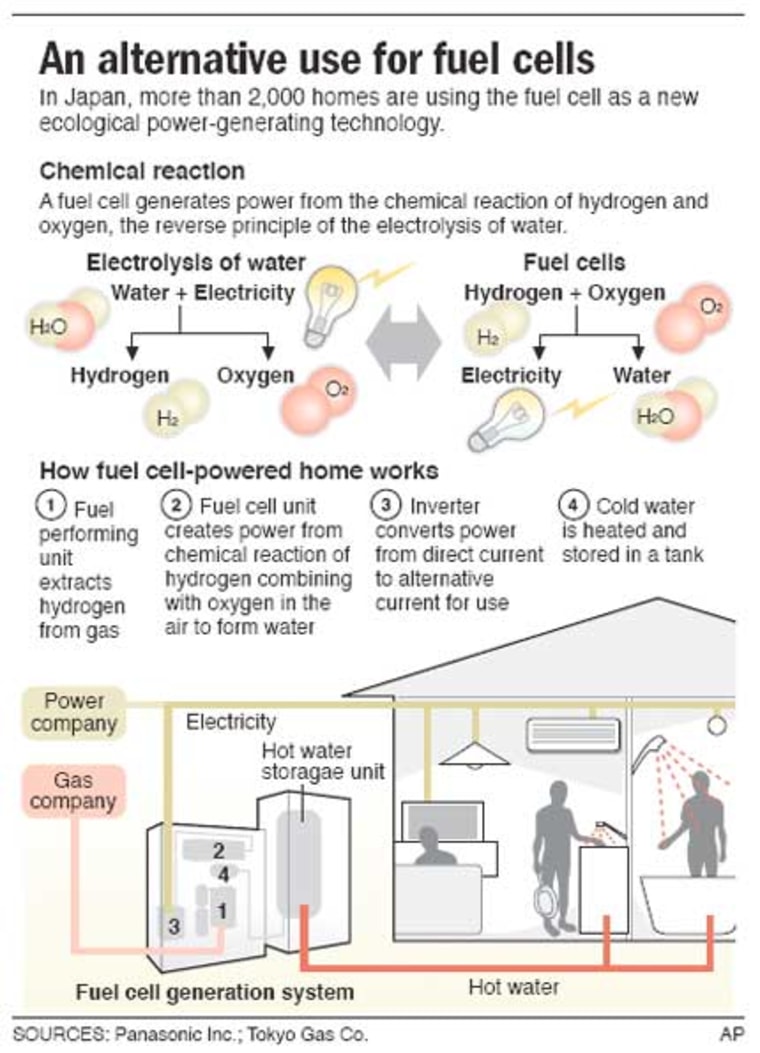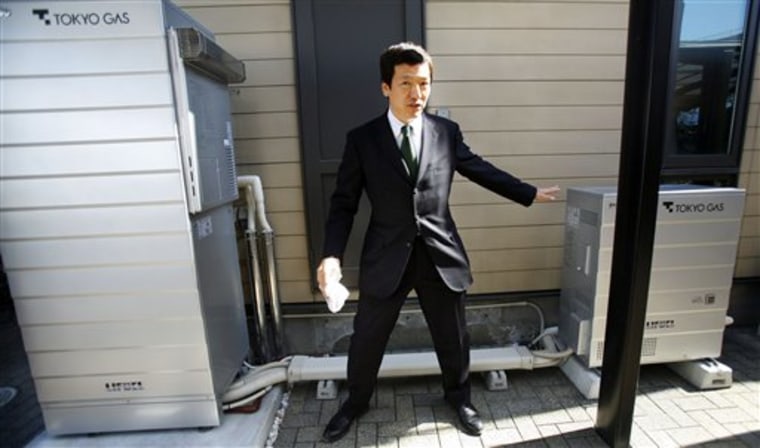Masanori Naruse jogs every day, collects miniature cars and feeds birds in his backyard, but he's proudest of the way his home and 2,200 others in Japan get electricity and heat water — with power generated by a hydrogen fuel cell.
The technology — which draws energy from the chemical reaction when hydrogen combines with oxygen to form water — is more commonly seen in futuristic cars with tanks of hydrogen instead of gasoline, a key culprit in pollution and global warming.
Developers say fuel cells that use natural gas to get hydrogen produce one-third less of the pollution that causes global warming than conventional electricity generation does.
"I was a bit worried in the beginning whether it was going to inconvenience my family or I wouldn't be able to take a bath," said the 45-year-old Japanese businessman, who lives with his wife, Tomoko, and two children, 12 and 9. But, as head of a construction company, he was naturally interested in new technology for homes.
Tomoko Naruse, 40, initially worried the thing would explode, given all she had heard about the dangers of hydrogen.
"Actually, you forget it's even there," her husband said.
Their plain gray fuel cell is about the size of a suitcase and sits just outside their door next to a tank that turns out to be a water heater. In the process of producing electricity, the fuel cell gives off enough warmth to heat water for the home.
The oxygen the fuel cell uses comes from the air and the hydrogen is extracted from natural gas piped to many homes for heating and cooking. A device called a reformer in the same box as the fuel cell does the extracting, which creates the poisonous byproduct carbon monoxide.
Another machine in the gray box cleans adds oxygen to make the carbon monoxide into carbon dioxide. Even though carbon dioxide contributes to global warming, it isn't poisonous.
The entire process produces less greenhouse gas per watt than traditional generation. And no energy is wasted transporting the electricity where it's actually going to be used.
Nearly every home in Japanese cities is supplied with natural gas, which could make it relatively easy to spread fuel cell technology there. The potential for widespread use of fuel cells in bigger or more sparsely settled countries is less certain. Many American homes don't have gas service, for example.
Cost is a drawback
"There are not any real show-stoppers for this technology being used in the U.S.," said electrical engineering professor Roger Dougal at the University of South Carolina at Columbia, S.C.
Dougal said fuel cells are no more hazardous than any stove or water heater. Their major drawback is cost.
"Ultimately, I expect that some fraction of homes will use this technology, but it will be a very long time before a sizable fraction does," he said in an e-mail.
Naruse is paying $9,500 for a 10-year lease on a test fuel cell for his home southwest of Tokyo from Matsushita Electric Industrial Co. Matsushita, which sells Panasonic brand products, plans to offer fuel cells commercially in 2009.

Other Japanese companies working on fuel cells for homes include Toyota Motor Corp., which is developing fuel-cell vehicles, and electronics maker Toshiba Corp. Automaker Honda Motor Co. is working with Plug Power Inc., a fuel cell company in the U.S., to test a home fuel cell generator that also provides hydrogen as fuel for fuel cell vehicles.
Honda hopes domestic use of fuel cell generators will help make fuel cell vehicles become more widespread because owners can refuel at home. It plans to start marketing the FCX Clarity fuel cell vehicle this year in California; it will lease for about $600 a month.
Fuel cells are expensive in part because they don't last very long. The latest model from Matsushita, for example, lasts about three years.
But the technology is improving. Matsushita says the savings from using fuel cell-generated power will vary by household and climate, but it promises a cost drop of about $50 a month.
Naruse's family — with three TV sets, a dishwasher, clothes washer, dryer, personal computer and air conditioner — saves about $95 a month. At the same time, conventionally generated electricity remains available to them, should the power generated by their fuel cell run low.
Goal: 1/4 of homes by 2020
The Japanese government is so bullish the technology it has earmarked $309 million a year for fuel cell development and plans for 10 million homes — about one-fourth of Japanese households — to be powered by fuel cells by 2020.
Professor Bruce Rittman, director for the Center for Environmental Biotechnology at Arizona State University, says the biggest benefit of fuel cell technology is that it emits only water — when there's a clean source of hydrogen.

"Fuel cells are wonderful devices because they provide combustionless, pollution-free electricity," he said.
Tomoko Naruse said she might never have chosen a fuel cell if her husband hadn't insisted.
But she is happy her children are proud of it because they are learning about the threat of global warming in school.
"I think my children are thinking are about the future," she said.
